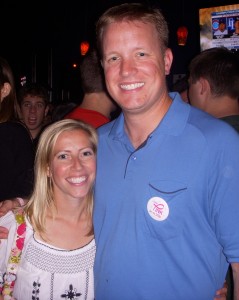
Tiffany and her husband, Dave, at a “Pre-Chemo” party the week before she started chemotherapy
Around this time last year, Tiffany found a small lump under her arm near her breast. The 28-year old knew that the lump was most-likely a benign cyst so she didn’t worry to much about it. Plus, as a typical health care consultant, she traveled Mondays through Thursdays during the week and wanted to spend weekends relaxing with her husband, not at a doctor’s office. Even as she scheduled the appointment, Tiffany was more focused on planning an upcoming spring trip to Italy and Greece than the lump. Then the tests came back. Breast cancer that had spread to her lymph nodes.
Tiffany barely remembers those first blurry days after the diagnosis. Her husband and parents came with her to the surgical consult where the physicians, “directed me to make appointments with a list of specialists including a fertility expert, medical oncologist, and genetic counselor,” she said in a recent interview at the Oncofertility Consortium. Tiffany recalls how her family scheduled appointments and helped her begin the treatment process. She soon met Kristin Smith, the oncofertility patient navigator in the Division of Fertility Preservation at Northwestern University, who explained her options. When asked about the decision-making process, Tiffany explained,” There was no choice. Of course I would do it.”
Tiffany and her husband decided to undergo embryo cryopreservation and Smith worked with the rest of the medical team to incorporate fertility treatment into the oncology schedule. According to Tiffany, “My oncologist wanted me to do chemotherapy first but knew that I wanted to undergo fertility preservation so she agreed that I could do surgery first.” After surgery, Tiffany began three weeks of hormone injections before egg extraction, fertilization with her husband’s sperm, and embryo freezing.
After completing the fertility preservation process, Tiffany underwent five months of chemotherapy and is currently more than half-way through two months of almost daily radiation and physical therapy. When reflecting on the fertility preservation process, she says, “At the time it was the littlest thing but now it is the most important,” since it gives her something to look forward to after treatment. Working with the oncofertility patient navigator Smith, “was the best part of treatment,” she says.
Though she is still in treatment, Tiffany has already begun to share her story. I first met her when she discussed her experience at an oncology nursing conference and almost brought the room to tears. She may also provide her personal perspective on fertility preservation to some of the high school students at the Oncofertility Saturday Academy. As Tiffany’s nine months of chemo- and radiation therapy come to a close in the middle of January, she is looking forward to starting her job again and, once her Tamoxifen treatment is completed, using those frozen embryos. But first there is that well-deserved European vacation…

